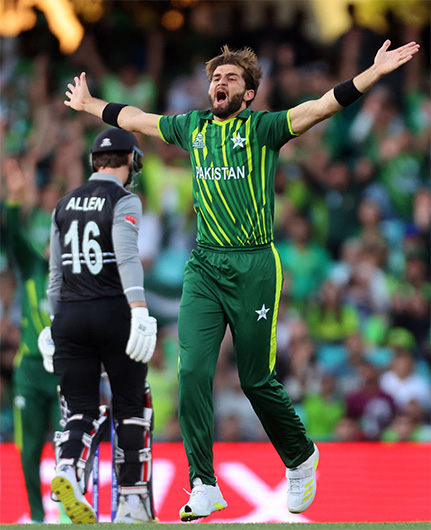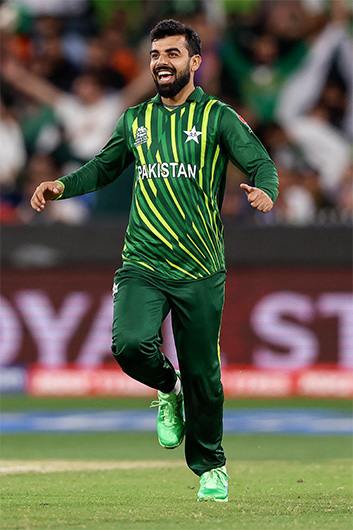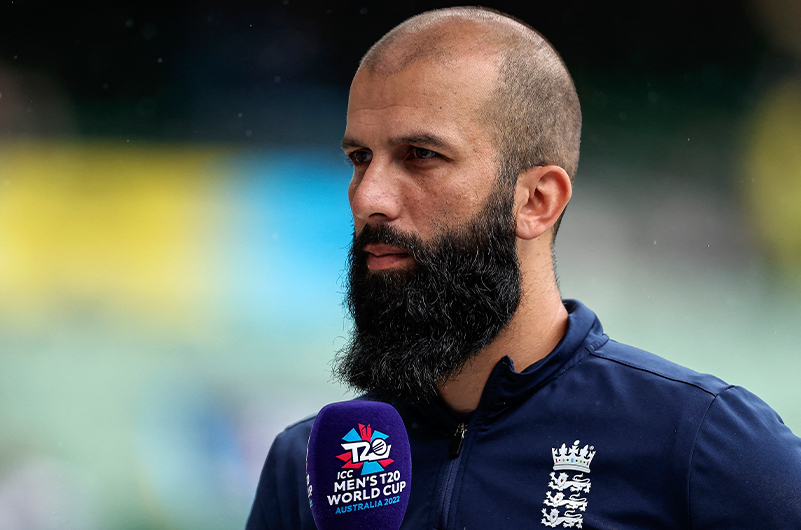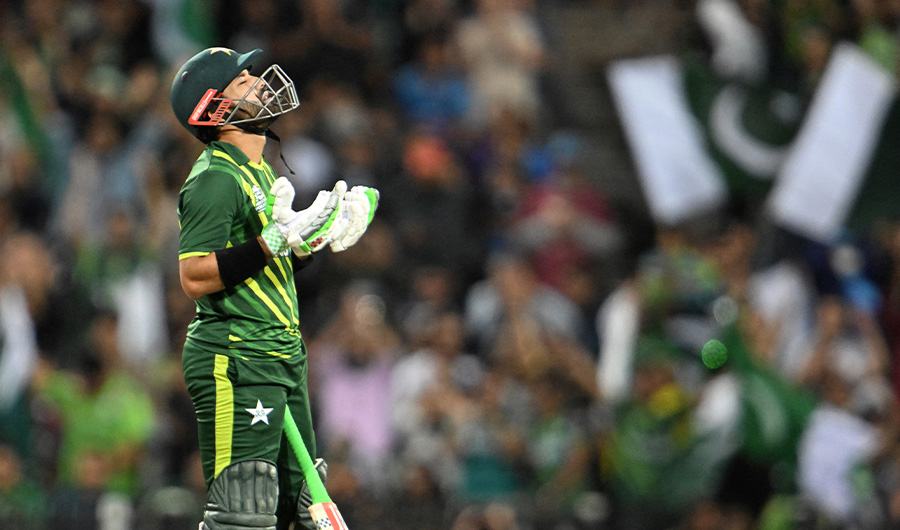ISLAMABAD: Pakistan and England will lock horns today, Sunday, for the final of the ICC T20 World Cup 2022 at the Melbourne Cricket Ground (MCG) with both sides boasting of plenty of matchwinners.
Cricket fans are salivating at the prospect of watching Pakistan’s pace battery colliding against England’s skilled batters. It will be a battle of nerves, for sure, at the grandest T20 stage of all.
Here are seven players to watch out for today:
1. Shaheen Shah Afridi

Pakistan's Shaheen Shah Afridi (R) makes a successful appeal for a leg before wicket (LBW) decision against New Zealand's Finn Allen during the ICC men's Twenty20 World Cup 2022 semi-final cricket match between New Zealand and Pakistan at the Sydney Cricket Ground in Sydney on November 9, 2022. (AFP)
The left-arm beanpole has come a long way since he made his debut for Pakistan a couple of years ago. Afridi is famous for his fiery in-swingers, that when delivered at full length and at a blistering pace, can eviscerate a batter’s toes any day of the week.
For cricket buffs, an Afridi first over is a sight for sore eyes. If England step into Melbourne today unprepared for Afridi’s ferocious yorkers, he will make them pay with pace.
2. Jos Buttler

England's Captain Jos Buttler celebrates win after the ICC men's Twenty20 World Cup 2022 semi-final cricket match between England and India at The Adelaide Oval on November 10, 2022 in Adelaide. (AFP)
One of the cleanest hitters of the ball, Buttler is one of the most dangerous batters in modern cricket. The England skipper has a penchant for opening the innings on a high note and denting the opposition by taking maximum advantage of the Powerplay overs.
Buttler loves to get creative on the field, often giving himself room to hit scoop shots that end up sailing over the boundary and leaving the bowler looking awfully helpless. He’s particularly strong on the leg-side and has repeatedly smashed fast bowlers over mid-wicket for lofty sixes.
Pakistan would do well not to bowl him on the leg-side.
3. Alex Hales

England’s Alex Hales reacts after hitting a shot during the ICC men's Twenty20 World Cup 2022 cricket match between England and Sri Lanka at the Sydney Cricket Ground (SCG) on November 5, 2022. (AFP)
Pakistan should keep a keen eye on Alex Hales. The tall, well-built batter will definitely look to put Pakistani pacers on the back foot by smashing boundaries every now and then during the Powerplay overs.
Given the thrashing that Hales and Buttler gave team India on Thursday, Pakistan would have certainly headed back to the drawing board with a plan for each opener after the second semifinal.
4. Haris Rauf

Pakistan's Haris Rauf celebrates his wicket of Afganistan's Azmatullah Omarzai during the ICC men's Twenty20 World Cup 2022 cricket warm-up match between Afghanistan and Pakistan at the Gabba in Brisbane on October 19, 2022. (AFP)
Since we’re talking dangerous pace, it would be unfair to leave out Rauf. The right-hand pacer has ample experience with Australian pitches, mainly due to his Big Bash League encounters Down Under.
Over the years, Rauf has become an economical bowler, mixing variations in the death overs to befuddle batters when they’re looking to score big boundaries. Rauf mixes up his line, length and pace to keep the batters guessing always, an obvious sign of any intelligent bowler.
5. Shadab Khan

Pakistan's Shadab Khan celebrates the wicket of India's Axar Patel during the ICC men's Twenty20 World Cup 2022 cricket match between India and Pakistan at Melbourne Cricket Ground (MCG) in Melbourne on October 23, 2022. (AFP)
Is there anything that Khan can’t do? The Pakistani all-rounder has emerged as one of the most integral members of the team’s limited-overs squad. A skilled leg-spinner who has mastered the art of bowling the googly, Khan’s aggressive batting has provided depth to Pakistan’s middle-order.
His quickfire half-century against South Africa was instrumental in sinking the Proteas and ultimately helping Pakistan qualify for the final four stage of the tournament.
When it comes to fielding, Khan is Pakistan’s best fielder by a mile. England better have a gameplan ready to tackle the all-rounder or he may end up being the difference between the two sides.
6. Moeen Ali

England's Moeen Ali speaks to reporters prior the ICC men's Twenty20 World Cup 2022 cricket match between Australia and England at Melbourne Cricket Ground (MCG) in Melbourne on October 28, 2022. (AFP)
England's answer to Pakistan's Shadab Khan. Ali is a viable bowling option who can pick up a few wickets here and there to slow down the run-rate.
However, his penchant for hitting sixes and pulling England out of dire straits and finishing the innings on a high note is what makes Ali lethal for today's match.
It would be interesting to see how he fares against Pakistan today.
7. Muhammad Rizwan

Pakistan's Muhammad Rizwan celebrates after scoring a half-century (50 runs) during the ICC men's Twenty20 World Cup 2022 semi-final cricket match between New Zealand and Pakistan at the Sydney Cricket Ground in Sydney on November 9, 2022. (AFP)
If Rizwan gets going with Babar Azam, it could very well be curtains for England. He’s not been in top-notch form during this tournament. However, Rizwan played a match-winning innings against New Zealand on Wednesday to see Pakistan through to the final.
Rizwan relishes any delivery bowled at his leg-side, slapping it away for his traditional ‘rib shot’ to the fence for a boundary. When boundaries are hard to get by, Rizwan keeps the scoreboard ticking by constantly finding gaps between the fielders and running singles and doubles.














